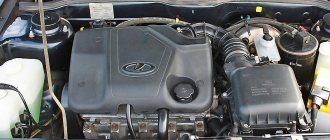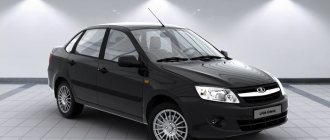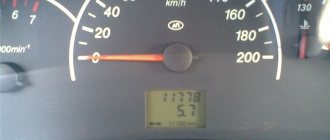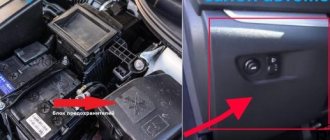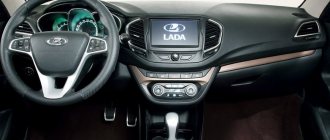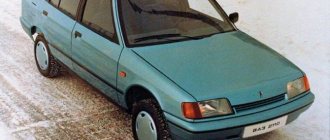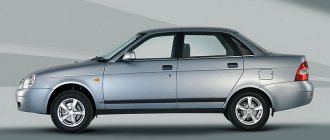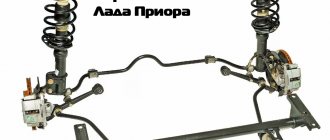Technical characteristics of Lada Vesta Sport
Announced two years ago, the Vesta Sport concept car is not much different from the production model. Which is surprising and unexpected, since previous models have significant differences.
The car received a forced 1.8-liter gasoline engine. The “heart” works in tandem with a five-speed manual transmission from Renault. Together, the mechanisms produce 145 horsepower, 187 Nm of torque, and a top speed of 198 km/h.
The first “hundred” is achieved in 9.6 seconds, the “maximum speed” is 198 km/h. Unfortunately, the model is not equipped with a turbocharger.
In the future, the manufacturer is considering the possibility of equipping the car with a variator from the Japanese manufacturer Jatco.
Car enthusiasts are familiar with the CVT from the Nissan model range. The transmission has proven itself well: with a long service life, available spare parts, and a budget price.
At the same time, the CVT is designed for a quiet, moderate driving style, but not for an aggressive, sporty one.
The all-wheel drive version is completely excluded, as this will automatically increase fuel consumption and reduce dynamic performance.
Unlike previous models, 20 mm of ground clearance was taken away from Vesta Sport. It is 162 mm. The basic configuration is equipped with a rear spoiler, an original front bumper, as well as extended wheel arches and decorative door sills.
Fuel consumption is 8.5 – 9.0 liters in the combined cycle.
The manufacturer did not forget about aerodynamic performance, increasing the size of the standard wheel rims by 17 inches, installing low-profile tires, and a rear bumper with branches for exhaust pipes.
The front suspension is MacPherson type, the rear is wishbone type, independent.
In order to improve the quality of handling, the standard chassis was modified. We installed racks with increased rod stroke. The new product has strengthened steering knuckles and disc brakes with an increased diameter.
Characteristics
Wake up
One in the morning, five thousand rpm, third gear. On the left and right sides, episodes from the school course fly by: Palace Square, the Bronze Horseman on Senateskaya, a sharp right towards the island on the Malaya Neva, and in my head are the remains of “atomic” espresso and advice from the racer and Lada Sport development boss Vlad Nezvankin. “Don’t be shy, turn it up to five thousand.” We are on a speed excursion around the center of St. Petersburg. Good night, city!
Lada_vesta
Car Lada Vesta Sport
Photo: Lada
Lada Vesta Cross drafted into the army
Military police and traffic police will switch to domestic cars
Actually, “his” is the 1.8-liter engine of the new Vesta Sport. No jokes or reservations - the flagship car of the current Lada family. Presented less than a month ago at a salon in Moscow, it evoked a strong desire to climb inside and escape from the chicken coop into the operational space of the summer Moscow region. Facts then prompted the crime: a modified chassis, new suspension and brakes, one and a half hundred horsepower and a clear Renault manual gearbox. At the same time, Lada President Yves Karakatzanis announced “more than two hundred changes in the design of the car.” From official to layman this was easily translated as “we have improved Vesta by 200 points.” Given the car's initial potential, the announcement was seen as a tease. “What is it like, a sports sedan, the Lada Sport division had a hand in creating?”
Wheels and braking system
Vesta Sport is equipped with new, reinforced hubs with five holes for fixation.
There are rumors that the design was copied from Renault Megane, but now this is not so important. But the 17-inch wheels on low-profile Continental tires look simply amazing.
The brake discs have been enlarged by 20 mm in diameter to improve braking performance. The air filter housing on the Lada Vesta Sport is borrowed from the sedan , identical, and interchangeable.
Exterior
The atypical shape of the front and rear bumpers is the main highlight of the new Vesta. Thanks to this, she is recognized from afar.
An “X-shaped” style runs along the entire perimeter of the body. The niches for the fog lights have become deeper, with small protrusions around the perimeter.
The final design element is a nameplate with the inscription “Sport” framed in red. It was copied from the Skoda Octavia.
On the sides you can see plastic door sill trims, the so-called “skirt”. The brand logo is applied to the surface.
The standard antenna of the radio is made in the form of a shark fin, similar to that installed on the basic versions of the SV and SV Cross.
The biggest changes affected the rear. New bumper with splitter for two exhaust pipe tips. There are pre-installed massive black ventilation inserts on the side.
The trunk lid is decorated with a small spoiler with a built-in brake light. At the bottom of the cover there is an information plate “VESTA Sport”.
The color scheme is presented in classic shades: black, blue, metallic, white, gray, Arctic, white night, yellow.
Body options: hatchback , coupe , wagon are being finalized. It is expected that in the near future they will replenish the current model range.
Interior
The interior frame is not much different from previous Lada Vesta models. Rather, the manufacturer worked on the little things rather than introducing fundamental solutions.
The steering wheel is neatly trimmed with eco-leather, red thread in the seam. The front seats have pronounced lateral support, like a real sports car.
For the first time, metal pads with rubber inserts were installed on the pedals. This prevents your foot from slipping while driving.
Bright colors were added to the dashboard, in particular red, which edged the arrows. The gear selector and handbrake lever are covered in leather.
Salon
AvtoMPS
| CATEGORIES OF POTENTIAL BUYERS | ||||||
| "CIVIL" | "CIVIL-SPORT" | "SPORTS" | G | g+s | With | |
| need for a class B car | “appear, but not be” (who are attracted by the “sport” in the name, but are far from sports) | track day enthusiasts, amateur racers, professional racers as a training car | ||||
| EMOTIONAL PERCEPTION | “foreign car” in the good sense of the word; composure and completeness, no matter how strange it may sound for a prototype - the fruit of work for only 1.5 years; pleasant tactile sensations from the controls, comfortable driver's seat, invigorating sound of the exhaust system | 80 | 80 | 80 | ||
| DESIGN | For me, it lacks lightness; the molding of the sidewalls and the lines of the moldings in the bumpers look a little forced; however modern, just not for everyone | 57 | 57 | 57 | ||
| WORK QUALITY | definitely “not China” and is in no way inferior to the zealous “Korea”; worthy | 77 | 77 | 77 | ||
| PRICE | quite adequate for this class of cars, but will become a barrier for fans of foreign cars | 70 | 70 | 70 | ||
| ENGINE, GEARBOX, ACCELERATION | 145 horsepower, 182 Nm and acceleration to 100 km/h within 10 seconds is great and sufficient, but it could also be more economical if there was a sixth gear in the gearbox | 145 horsepower, 182 Nm and acceleration to 100 km/h within 10 seconds is enough, but it could be better with a six-speed gearbox and the possibility of purchasing inexpensive software to increase power characteristics by 5-7% | 145 horsepower, 182 Nm and acceleration to 100 km/h within 10 seconds is a good donor that will need a kit to increase power, install a lock and a “short” 6-speed gearbox. It is also advisable to throw out anything unnecessary weighing 100 kilograms from the car. | 82 | 69 | 65 |
| ECONOMICAL | In quiet urban driving mode, fuel consumption was 11.8 liters per hundred, which in my opinion is a bit too much, and in test tests, working in the most uneconomical modes - constant acceleration and braking, high speeds, increased rolling and sliding resistance - the hog computer showed 13.6 liters and This is unsurprisingly unpleasant. | 60 | 60 | 60 | ||
| STEERING, SUSPENSION, WHEELS, TIRES | The “sharp” steering wheel and such powerful suspensions will most likely seem harsh to a car enthusiast without sporting ambitions, but this is only “out of ignorance.” R17 wheels specially designed for LADA VESTA are a strong argument for buying a car with them - they are very beautiful. But the 17th radius can be scary due to the costs when changing tires. | The relatively “sharp” steering wheel and energy-intensive suspension will generously give the advanced enthusiast a sporty feeling already at civilian speeds. Seventeenth wheels are an important “show-off”, and they also benefit in the form of good handling. Tires are like tires, for all occasions. An advanced amateur, after wearing them out, on the advice of friends, will want to try something else, less universal, and most likely, having played enough, he will understand that the Conti were not so bad. | The steering wheel works correctly and quite sharply conveys the feeling of the road on all summer surfaces, including in a well-warmed-up state. The pendants are objectively good. Energy intensity is high, and compression and rebound are sufficient both on tram tracks and other uneven surfaces, and at speeds of 90+. Energy intensity allows you to fall on light unpaved roads, even on civilian “kontiki” vehicles, without corrections for deviation from a given trajectory or breakdowns, etc. troubles. Well, 17th radius is the norm for full-size cars with ambitions | 73 | 80 | 84 |
| BRAKES | With a large margin and excellent information content. ABS works correctly. | If you leave the car stock, ABS will significantly limit the ability to pilot during braking processes and use the brake pedal to work with the balance of the car. | 100 | 100 | 50 | |
| ERGONOMICS | There are all the modern features of class B cars, including climate control, a rain sensor, etc. Special respect to the driver’s seat - the seat is excellent - comfortable, with a long back, developed lateral supports, with the necessary adjustments; the steering wheel is thick, fits well in the palm of your hand, giving the maximum possible contact area; All controls are in their usual places. The pedal assembly is located symmetrically to the seating position. | 80 | 80 | 80 | ||
| INTERIOR COMFORT | with a height of 190 - there is a lot of legroom, but the height of the back seat does not fit, the trunk is huge, the seats partially fold | 75 | 75 | 75 | ||
| VERSATILITY | On high! The lower ground clearance relative to the standard Vesta certainly took away a little in geometric cross-country ability, but the suspensions became more energy-intensive for compression. | And to the feast, and to the world, and to the races! | 78 | 78 | 80 | |
| SAFETY | ABS works correctly, ESC - the exchange rate stability system is present, operates smoothly, and provides a small range for wheel slip. A minimum set of airbags is present. The seat belts and headrest are comfortable and have a wide range of height adjustment. | This is the case when electronic stabilization systems are an obstacle to safe and reliable driving of a car. Therefore, for athletes there is a button to turn off ESC, but turning off ABS can only be done by removing the corresponding fuse. | 80 | 80 | 68 | |
| RESULT | 76 | 76 | 71 | |||
Equipment Lada Vesta Sport
The basic version of Vesta will be packed richly. The standard equipment includes ABS and EBD, BAS and ESC, TCS and HSA options. Besides:
- Daytime Running Lights;
- PTF – fog lights;
- two airbags, one each for the passenger and driver;
- electronic engine control unit, also known as on-board computer;
- multifunction steering wheel;
- radio with 7.0-inch liquid crystal display, support for Touch Screen function, FM/AM, USB, SD card, AUX, Bluetooth, Hands free, 6 speakers;
- passive cruise control;
- air conditioning system;
- light and rain sensors;
- parking sensors;
- heated mirrors and windshield;
- Rear View Camera;
- LED backlighting of mechanical buttons.
Review of Vesta S-line and R versions
Rospatent has already registered trademarks for both of these models of the new Lada. The manufacturer plans to use an individual logo for each.
In the “S-Line” the interior has been significantly improved, spoilers, designer rims, wheels, and door sills have been installed. In a word, sports charisma.
There is little information about the "R" model. Two types of power units with a volume of 1.6 liters (140 hp), which are copied from Kalina. The second engine is 150 hp. and volume 1.8 liters. In the future, it is planned to expand the line with another 180 hp, 2.0 liter engine.
Vesta S-line
mail.ru
- At first, the engine itself does not reveal its essence in any way - on the contrary, there is not even enough traction at the bottom.
- The engine is good at medium speeds.
- Acceleration, of course, cannot be called fantastic, and on the highway we could barely catch up with the local Kalina Sport, which in some places was traveling 180 km/h.
- Starting from a standstill is complicated by the unexpectedly uninformative clutch.
- The gas pedal here is set “sharper” than in regular Vestas.
- The gearbox from Renault does not please with long strokes and not the highest clarity of inclusions.
- You experience maximum pleasure not on the highway, but on winding serpentines.
- Vesta unexpectedly tenaciously stands on the arc, and when releasing the gas, it willingly turns the rear axle.
- The stabilization system does not interfere too much with the process, and in damp areas it even helps, effectively coping with wheel slip.
- If you turn off the stabilization system, then at the exit of the turn you will have to very precisely dose the traction, otherwise the car will go outward under the squeal of the unloaded front wheel.
- The feedback is so good that you feel everything that happens to the front wheels.
- At speed, the coating seems to smooth out, all those bumps and roughness noticeable in the city go away.
- It easily copes with both waves and sagging asphalt - there is enough travel to rebound.
- There are no complaints about the brakes - the effort on the pedals is pleasant, they grip immediately, without unnecessary free play, there is no hint of overheating.
Lada Vesta Sport will become the most powerful production Lada
AvtoVAZ structural divisions are actively working on the configuration and equipment of the Lada Vesta Sport. It is expected that the new product will receive a 1.8-liter engine, the number of horsepower will be increased from 122 to 150. The presentation is scheduled for 2021.
The standard phase shifter will be replaced with a new, modernized one. The intake-exhaust system has been improved, two new camshafts.
The ultimate goal of the engineers is to create a car more powerful than the Lada Kalina NFR, which is currently considered the most powerful in the family.
The rear brakes will be equipped with discs whose diameter will be increased from 260 to 286 mm. The wheels will be 18 inches, and the ground clearance will be increased by 45 mm. But the seats will be left from the previous Vesta.
Behind the wheel
About the engine:
- Faster, of course, than the 122-horsepower 1.8 engine, although it doesn’t deserve the title “sport”.
- The impressions from the 145-horsepower version of the 1.8 engine are approximately the same as from its original version. It reveals itself better on the highway than in the city.
About the suspension
:
- She's fantastic. VAZ engineers managed to bring taxiing accuracy to new heights without losing one bit in energy consumption.
About the exhaust system
:
- First impression: why is it so loud? In the city with starts from traffic lights, this seems cool, but on the highway it quickly becomes annoying.
- From the outside, the sound is quite decent in volume and even has noble notes.
The car infected me with its spirit and even, damn it, made me think about buying it.
Link to test drive.
Reviews
| № | Positive |
| 1. | Vasily: Vesta in its basic configuration has proven itself on the positive side; few people complain about the quality. It's a pity that the same cannot be said about the Lada Granta. I am sure that the new models will be much better than the previous ones. |
| 2. | Dmitry: I am proud of the domestic manufacturer. Cars in an affordable price segment, a wide selection of spare parts. Breakdowns happen, it’s no secret, but they can be easily fixed on your own. |
| 3. | Kirill: my car is six months old, I bought it from scratch at the dealership. Apart from replacing consumables, I did not make any investments. Our people have finally learned how to make cars. Lada Vesta - my recommendations for motorists. |
| 4. | Gennady: new models of the domestic brand are good, both in price and in quality. Prices are affordable for families with an average budget. The assembly is several times better than Grants, Kalinas, Largus. |
| 5. | Vladislav: I’ve been actively using the car for a year, I have no complaints, all the mechanisms work properly. I believe that the most important thing for a car is systematic care and maintenance. |
| 6. | Konstantin: my positive review of the Lada Vesta, I purchased the model a year ago. During this time I only changed the oil and filled up with fuel. |
| 7. | Vladimir: I thought for a long time about what to buy, my comrades convinced me to take a domestic manufacturer. I'm happy with the solution, no complaints. |
| Negative | |
| 1. | Victor: despite the small breakthrough of the Russian manufacturer, the quality of workmanship remained at the same level. The basic Lada models are generally meager, no bells and whistles, you have to buy everything yourself. |
| 2. | Vasily: I thought about buying a Vesta, but my friends dissuaded me from buying a Renault Logan. I'm happy with the choice, no comments. |
| 3. | Dmitry: after a year of active use, the car begins to crumble. I have already visited a service station twice unscheduled for diagnostics and repairs. |
